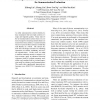Free Online Productivity Tools
i2Speak
i2Symbol
i2OCR
iTex2Img
iWeb2Print
iWeb2Shot
i2Type
iPdf2Split
iPdf2Merge
i2Bopomofo
i2Arabic
i2Style
i2Image
i2PDF
iLatex2Rtf
Sci2ools
ACL
2012
2012
Combining Coherence Models and Machine Translation Evaluation Metrics for Summarization Evaluation
An ideal summarization system should produce summaries that have high content coverage and linguistic quality. Many state-ofthe-art summarization systems focus on content coverage by extracting content-dense sentences from source articles. A current research focus is to process these sentences so that they read fluently as a whole. The current AESOP task encourages research on evaluating summaries on content, readability, and overall responsiveness. In this work, we adapt a machine translation metric to measure content coverage, apply an enhanced discourse coherence model to evaluate summary readability, and combine both in a trained regression model to evaluate overall responsiveness. The results show significantly improved performance over AESOP 2011 submitted metrics.
ACL 2012 | Computational Linguistics | Discourse Coherence | Regression Model | Summarization Systems |
| Added | 29 Sep 2012 |
| Updated | 29 Sep 2012 |
| Type | Journal |
| Year | 2012 |
| Where | ACL |
| Authors | Ziheng Lin, Chang Liu, Hwee Tou Ng, Min-Yen Kan |
Comments (0)

